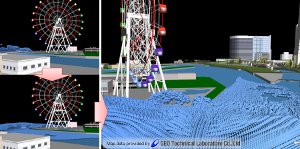Archived content
NOTE: this is an archived page and the content is likely to be out of date.
Fujitsu and Tohoku University Collaborate on High-Precision 3D Tsunami Simulation Research
Aims to precisely simulate tsunami inundation in urban areas, elucidate failure mechanisms of reinforced concrete buildings
Fujitsu Limited
Tokyo, February 21, 2012
Fujitsu today announced that it has signed a collaborative research contract with Tohoku University on 3D tsunami simulations that can precisely calculate inundation on land and in rivers. The research will primarily focus on simulating inundation in urban areas and rivers and elucidating the mechanisms leading to structural failures of reinforced concrete buildings.
The goal of this research is to develop a new 3D tsunami simulation technique. This is to be achieved by integrating a 3D fluid simulation technology that runs on large-scale parallel computers using a Fujitsu-developed smoothed-particle hydrodynamics(1) method, together with a 2D tsunami-propagation simulation technique developed by Japan's preeminent tsunami researcher, Professor Fumihiko Imamura, director of the Disaster Control Research Center in Tohoku University.
Results of this research could be used in the design of levees and evacuation shelters, and to develop guidelines for hazard maps and evacuation routes. This promises the production of reliable disaster-response and disaster-mitigation tactics.
While applying this technology to the processing power of computers, Fujitsu seeks to support the recovery and revival of the region affected by the Tohoku earthquake by continuing to leverage ICT in facilitating initiatives to build a society that is more resilient to disasters.
Background
The Great East Japan Earthquake of March 11, 2011, and the tsunami it caused devastated the Tohoku region. In towns such as Onagawa in Miyagi Prefecture, the tsunami knocked over reinforced concrete buildings, an unprecedented failure. This highlighted the need to elucidate the mechanisms behind these structural failures. As a tsunami-preparedness measure, there is a stronger demand than ever before to use tsunami-simulation technology to predict flooding, assess the vibration resistance of structures, and analyze the mechanisms behind the structural failure of buildings.
Technological Issues
Tsunami simulations have been performed around the world for some time. To accurately calculate the force that a tsunami can exert on a building, or simulate flooding patterns or river surges in an urban area, however, it will be essential to have a 3D simulation that takes into account data including the shape of buildings, levees and other three-dimensional objects that will affect the power of the tsunami and the speed of a river surge. So vast is the amount of information being calculated that, even using a massive parallel PC cluster of 500 machines, simulations can take five days. This is why such simulations are almost never run.
Focus of the Research Collaboration
As part of his research on tsunamis, Professor Imamura developed a 2D simulation of a tsunami that analyzes tsunami propagation from its hypocenter source. This simulation technique is widely used to calculate the arrival time and wave height of a tsunami along coastal areas, but it is limited in its ability to handle the considerable influence that buildings and topography will have on urban inundation and river surges.
Fujitsu has developed a smoothed-particle hydrodynamic simulation technique as an application that runs on massive parallel computers. The smoothed-particle hydrodynamic method is one that treats a fluid as a collection of numerous particles, and one of its advantages is its ability to analyze phenomena, such as wave breaks(2), that are a challenge for other methods. An issue for this method was that simulated waves gradually attenuated as they were transmitted, but a new technology(3) has been developed that addresses this issue. This improvement accurately replicates the motion of waves, with a 10% margin for error compared to the results of a wave tank that accurately models wave motion. Applying this technology to tsunamis should permit the analysis of the mechanisms underlying its various phenomena.
This research will develop a new 3D tsunami simulation technique that merges Professor Imamura's 2D tsunami-propagation simulations with Fujitsu's smoothed-particle hydrodynamic simulation technique. The research collaboration will specifically focus on the following:
- Simulation of urban-area flooding and river surges caused by a tsunami
- Elucidating failure mechanisms of reinforced concrete buildings in tsunamis
By applying the processing power of computers to the technologies resulting from this research, Fujitsu seeks to contribute to improved disaster preparedness and disaster mitigation through a better understanding of a tsunami's mechanisms.
About Fujitsu
Fujitsu is the leading Japanese information and communication technology (ICT) company offering a full range of technology products, solutions and services. Over 170,000 Fujitsu people support customers in more than 100 countries. We use our experience and the power of ICT to shape the future of society with our customers. Fujitsu Limited (TSE:6702) reported consolidated revenues of 4.5 trillion yen (US$55 billion) for the fiscal year ended March 31, 2011. For more information, please see http://www.fujitsu.com
Press Contacts
Public and Investor Relations Division
Inquiries
Company:Fujitsu Limited
All other company or product names mentioned herein are trademarks or registered trademarks of their respective owners. Information provided in this press release is accurate at time of publication and is subject to change without advance notice.
Date: 21 February, 2012
City: Tokyo
Company:
Fujitsu Limited,
,
,
,
,
,
,
,
,
,
